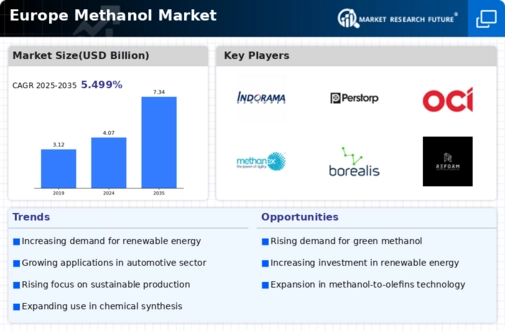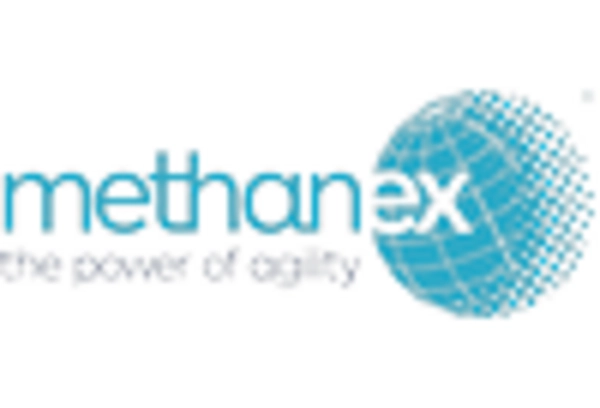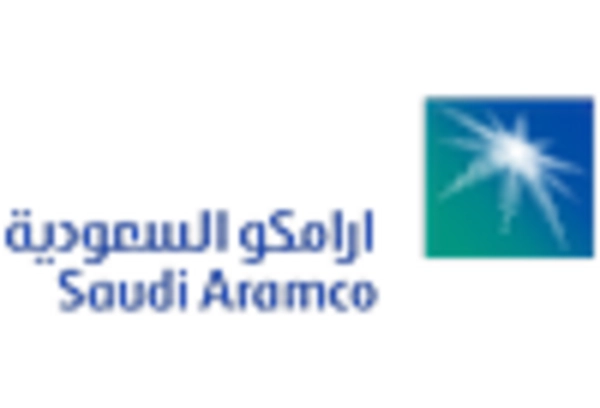Regulatory Support for Clean Energy
The methanol market in Europe is experiencing a notable boost due to increasing regulatory support for clean energy initiatives. Governments across the region are implementing stringent regulations aimed at reducing carbon emissions, which is driving the demand for methanol as a cleaner alternative to traditional fossil fuels. For instance, the European Union has set ambitious targets to achieve carbon neutrality by 2050, which is likely to enhance the role of methanol in various sectors, including transportation and energy production. This regulatory framework not only encourages investment in methanol production facilities but also promotes research and development in the methanol market, potentially leading to innovative applications and increased market share.
Expansion of Methanol Production Capacity
The methanol market in Europe is poised for growth due to the expansion of production capacity across the region. Several key players are investing in new facilities and upgrading existing plants to meet the increasing demand for methanol in various applications, including chemicals and fuels. For example, recent reports indicate that methanol production capacity in Europe is expected to increase by approximately 15% by 2027, driven by both domestic and international demand. This expansion is likely to enhance the competitiveness of the methanol market, allowing for greater economies of scale and improved supply chain efficiencies. As production capacity grows, it may also lead to more stable pricing and availability of methanol in the market.
Rising Demand for Renewable Energy Sources
The methanol market in Europe is significantly influenced by the rising demand for renewable energy sources. As countries strive to transition from fossil fuels to more sustainable energy solutions, methanol is emerging as a viable option due to its versatility and lower environmental impact. The European market is projected to witness a compound annual growth rate (CAGR) of approximately 6% over the next five years, driven by the increasing adoption of methanol in renewable energy applications such as fuel cells and as a hydrogen carrier. This shift not only aligns with the region's sustainability goals but also positions the methanol market as a key player in the energy transition, potentially attracting further investments and technological advancements.
Growing Interest in Methanol as a Marine Fuel
The methanol market in Europe is witnessing a growing interest in methanol as a marine fuel, driven by the shipping industry's efforts to comply with stricter emissions regulations. The International Maritime Organization has set ambitious targets to reduce greenhouse gas emissions from ships, prompting shipowners to explore alternative fuels. Methanol, with its lower emissions profile compared to traditional marine fuels, is emerging as a promising solution. The European market is likely to see an increase in methanol-powered vessels, which could significantly impact the methanol market. This trend not only aligns with environmental goals but also presents opportunities for investment in infrastructure and technology development, potentially leading to a more sustainable maritime sector.
Technological Innovations in Production Processes
Technological innovations are playing a crucial role in shaping the methanol market in Europe. Advances in production processes, such as the development of more efficient catalytic methods and the integration of renewable feedstocks, are enhancing the overall efficiency and sustainability of methanol production. These innovations not only reduce production costs but also minimize the environmental footprint associated with methanol manufacturing. The methanol market is likely to benefit from these advancements, as they could lead to increased adoption of methanol in various sectors, including automotive and energy. Furthermore, the ongoing research in carbon capture and utilization technologies may further bolster the methanol market, positioning it as a key component in the circular economy.

















Leave a Comment